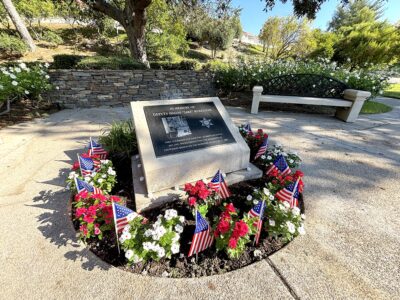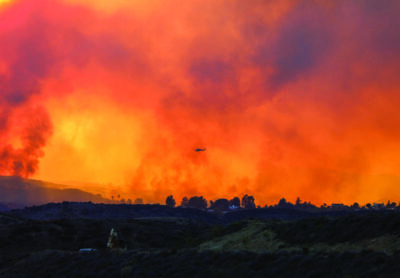
He told his son, who set up the interview, that he didn’t think he had much to talk about.
On May 13, Castaic resident Kenneth Placek will be 102 years old. He’s a decorated World War II fighter pilot who flew almost 100 combat missions. After receiving a bachelor’s degree in business from the University of North Dakota, he worked a successful career in the insurance business, and with his wife, he helped raise three kids. He has six grandchildren and three great grandchildren.
Not much to talk about?
“I could show some stuff,” Placek said in a room in his home that’s filled with World War II pictures, medals and even, hanging from the ceiling, a model of the P-47 Thunderbolt plane that he flew in the war. “I’ve got lots of memorabilia.”
He got right into showing pictures and items from the war. Each item he showed had a story, and one story led to another and another. He quickly got to his recollections of his arrival in Scotland the day before D-Day, June 6, 1944.
“They put us on a train down to England to a center where they would, of course, assign you to various units,” Placek said. “Since the Germans didn’t come up, they took us to the air base and gave us another 20 hours of flying. These people who trained us there were veteran pilots who had already finished their operations, and they were going home. So, they inaugurated us. That 20 hours was probably the difference between an ace and an ass.”
The following month, Placek and his unit arrived at a base in Normandy. His first flight was right around the time Gen. George S. Patton’s army was moving west into Brittany for what would become the Battle of Brittany. Placek said it was during his first flight that he miraculously made it safely back to base.

He said he was flying No. 2 in formation and noticed that his No. 1 had made a strange maneuver. Placek demonstrated the move with his two hands, showing that, at the time, he had followed his No. 1.
“When we landed,” Placek said, “he (No. 1) says, ‘Didn’t you see the flak (anti-aircraft fire) that was coming right up at us? That’s why I made that maneuver, so it wouldn’t hit me.’ I never knew what was going on. I was so busy looking at him and trying to stick with him with every maneuver he made.”
That, Placek said, might’ve been what saved him from getting hit that day.
As he flew more combat missions, Placek would come to learn how to fly through flak, which, as depicted in the 2024 World War II miniseries “Masters of the Air,” poses serious threats to both aircraft and airmen.
“The Germans usually had four 88s (88 mm anti-aircraft artillery guns) that shot up at once, trying to get you,” Placek said. “The first burst of flak — you’d see the big black burst below — it would come up, and it’d be fairly close to us sometimes, but immediately we counted. Like, if we were at 10,000 feet, we counted, ‘One-thousand one, one-thousand two.’ At ‘one-thousand ten,’ we’d make return. Well, the Germans were tracking us during those 10 seconds, and they were going to shoot where we were, but we weren’t there when they got there.”
Placek added that the trick to avoiding flak was to turn up, never down. At the speed they were moving, he said he and his fellow flyers never had to count to 10 more than twice before they were out of range.
Placek casually talked about the time he got shot down in Germany. He was on a mission and had been zeroing in on some ground artillery.
“He (the enemy operating the ground artillery) was trying to bring the gun around on me,” Placek said, “and I thought, ‘I got you, buddy.’ But someone else on the horizon picked me off. My airplane flew, but the L rods (linkage rods) were all ‘rockedy’ and I couldn’t get airspeed to think of. One of the other pilots went ahead, and I turned back toward our lines.”
Placek located a big field in occupied territory, and he force-landed there.
He landed right next to an American radar outfit, which he couldn’t identify from the air. It was camouflaged.
“This young guy jumped up on the wing,” Placek said, “and he says, ‘Are you OK?’ I says, ‘Yeah. It’s about 12 o’ clock, got any lunch for me?’”
Placek still has the clock from that plane. Once on the ground, he found a screwdriver and removed it from the cockpit. He keeps it with his other stuff from the war.

Born on Mother’s Day, May 13, 1922, in Austin, Minnesota, Placek grew up with no aspirations of joining the military. But during World War II, the United States implemented the Selective Service system, known as the draft, and that pushed him to volunteer because if he was drafted, “they could send you almost any place,” he said.
He chose to be a pilot because one of his best friends was doing the same. The two of them did everything together, he said. However, his best friend didn’t make it because he failed the eye test. Placek got in.
“Before I joined, I’d never flown in an airplane,” Placek said. “It was a new experience.”
Placek became an aviation cadet in November 1942. During his training, while in Oxnard, he was tasked with a cross-country flight to Newhall in which he’d have to navigate using only the landscape below. He followed the railroad tracks until he located the old courthouse in Newhall, turned there and flew back to Oxnard.
Those were skills he might need in the war. He still has his military-issued “silk escape map,” a navigational tool he carried at the time. The map is made from silk so that if he was on the ground in enemy territory, it wouldn’t make noise like paper would and it wouldn’t get damaged in the rain and such.
Upon finishing his training, Placek was commissioned to second lieutenant and subsequently promoted to first lieutenant. He went overseas with the 378th Fighter Group of the Ninth Air Force, nicknamed Mogin’s Maulers, in February 1944.

According to a list of accomplishments he wrote down on a piece of paper, Placek flew a total of 95 combat missions, totaling 240 combat hours and 675 military hours.
He took part in battles and campaigns that included Normandy, North France, Rhineland, Ardennes and Central Europe.
Placek served a total of one year and seven months overseas. For his service, he received the Air Medal with 16 oak leaf clusters, the Distinguished Flying Cross and the Distinguished Unit Badge with one cluster.

He came home in November 1945. In February 1949, he received his bachelor’s degree in business from the University of North Dakota.
Placek spent a career in the insurance business, working for various companies as an underwriter and Medicare hearing officer. He retired in 1986. He and his wife, Doreen, would have two sons and a daughter, six grandchildren and three great grandchildren over the years.
Doreen died in 2019 at 94 years old, less than two weeks before her 95th birthday. Placek currently lives in Castaic with his oldest son, Paul, and their pet beagle, Eileen Clare.
Placek has got quite a bit of memories in frames on his walls and in folders and books in what might as well be called the “war room” in the house. In one scrapbook, he has a number of pages dedicated to those he served with. He had a few pages labeled “The Glory,” which included photographs of guys who made it out of the war, and other pages labeled “The Agony,” which included photographs of guys who didn’t.
Placek pointed to a few of those photos and added commentary: “He got killed … This one — his parachute didn’t open up.”
Placek said he’s never returned to any of the locations where he fought during the war, adding that it never really interested him to do so. He doesn’t have nightmares of that time in his life like some guys do, but he also never really wanted to fly again. He said he doesn’t even particularly like flying as a passenger, adding that he got his fill of flying in the war.

These days, Placek said he just tries to keep mobile. He takes walks around the neighborhood, and he goes to nearby parks and feeds the squirrels.
“He likes to take the beagle out to feed the squirrels,” Placek’s son Paul said. “But they don’t go together — squirrels and beagles.”
Placek said the stories he shared didn’t scratch the surface of his overall journey. This, from a man who had claimed he didn’t have much to share.
Know any unsung heroes or people in the SCV with an interesting life story to tell? Email [email protected].









